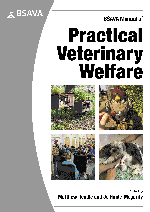
Full text loading...

Nutrition is fundamental to the health and wellbeing of animals and is an aspect of husbandry in which owners and caregivers play a critical role. It is the responsibility of the veterinary team to equip owners with the knowledge to make informed decisions about what and how to feed animals in their care. This chapter covers nutritional assessment, welfare considerations of different types of diet and feeding methods, and clinical diseases related to poor nutritional welfare.
Nutritional welfare, Page 1 of 1
< Previous page | Next page > /docserver/preview/fulltext/10.22233/9781910443798/BSAVA_Manual_Welfare_1_9781910443798.5.124-145-1.gif

Full text loading...


 = can be offered daily;
= can be offered daily;  = can be offered sometimes/as an occasional treat;
= can be offered sometimes/as an occasional treat;  = should never be fed; – = no information available. © 2022 British Small Animal Veterinary Association
= should never be fed; – = no information available. © 2022 British Small Animal Veterinary Association
 = can be offered daily;
= can be offered daily;  = can be offered sometimes/as an occasional treat;
= can be offered sometimes/as an occasional treat;  = should never be fed; – = no information available.
= should never be fed; – = no information available.


